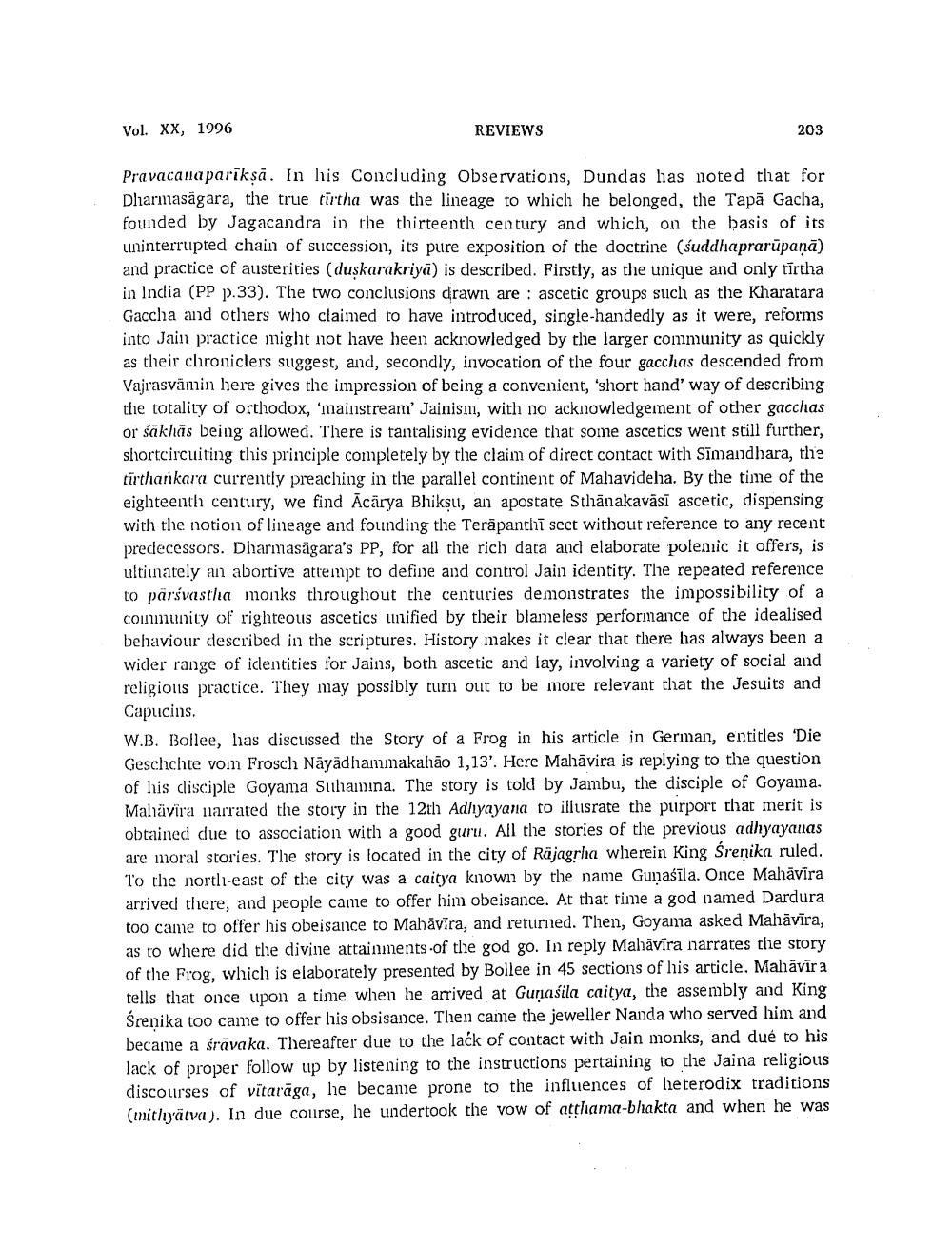________________
Vol. XX, 1996
REVIEWS
203
Pravacanapariksa. In his concluding Observations, Dundas has noted that for Dliarmasägara, the true tirtha was the lineage to which he belonged, the Tapā Gacha, founded by Jagacandra in the thirteenth century and which, on the basis of its uninterrupted chain of succession, its pure exposition of the doctrine (śuddhaprarūpaņā) and practice of austerities (duskarakriyā) is described. Firstly, as the unique and only tīrtha in India (PP p. 33). The two conclusions drawn are: ascetic groups such as the Kharatara Gaccha and others who claimed to have introduced, single-handedly as it were, reforms into Jain practice might not have been acknowledged by the larger community as quickly as their chroniclers suggest, and, secondly, invocation of the four gacchas descended from Vajrasvämin here gives the impression of being a convenient, 'short hand' way of describing the totality of orthodox, mainstream' Jainism, with no acknowledgeinent of other gacchas or säkhas being allowed. There is tantalising evidence that some ascetics went still further, shortcircuiting this principle completely by the claim of direct contact with Sīmandhara, the tirtharikara currently preaching in the parallel continent of Malavideha. By the time of the eighteenth century, we find Ācārya Bhiksli, an apostate Sthanakavāsi ascetic, dispensing with the notion of lineage and founding the Terapanthi sect without reference to any recent predecessors. Dharmasagara's PP, for all the rich data and elaborate polemic it offers, is ultinately an abortive attempt to define and control Jain identity. The repeated reference to pārsvastha monks throughout the centuries demonstrates the impossibility of a community of righteous ascetics unified by their blameless performance of the idealised behaviour described in the scriptures. History makes it clear that there has always been a wider range of identities for Jains, both ascetic and lay, involving a variety of social and religiolis practice. They may possibly turn out to be more relevant that the Jesuits and Capucins. W.B. Bollee, las discussed the Story of a Frog in his article in German, entitles 'Die Geschchte vom Frosch Näyädhammakahāo 1,13'. Here Mahāvira is replying to the question of his clisciple Goyama Suhamına. The story is told by Jambu, the disciple of Goyama. Mahävira narrated the story in the 12th Adlıyayana to illusrate the purport that merit is obtained due to association with a good guru. All the stories of the previous adhyayanas are moral stories. The story is located in the city of Räjagrha wherein King Srenika ruled. To the north-east of the city was a caitya known by the name Gunaśīla. Once Mahävira arrived there, and people came to offer him obeisance. At that time a god named Dardura too came to offer his obeisance to Mahāvīra, and returned. Then, Goyama asked Mahāvīra, as to where did the divine attainments of the god go. In reply Mahāvīra narrates the story of the Frog, which is elaborately presented by Bollee in 45 sections of his article. Mahävīra tells that once upon a time when he arrived at Gurasila caitya, the assembly and King Śrenika too came to offer his obsisance. Then came the jeweller Nanda who served him and became a srāvaka. Thereafter due to the lack of contact with Jain monks, and due to his lack of proper follow up by listening to the instructions pertaining to the Jaina religious discourses of vitaraga, he became prone to the influences of heterodix traditions (mnitlyätva). In due course, he undertook the vow of atthama-bhakta and when he was




